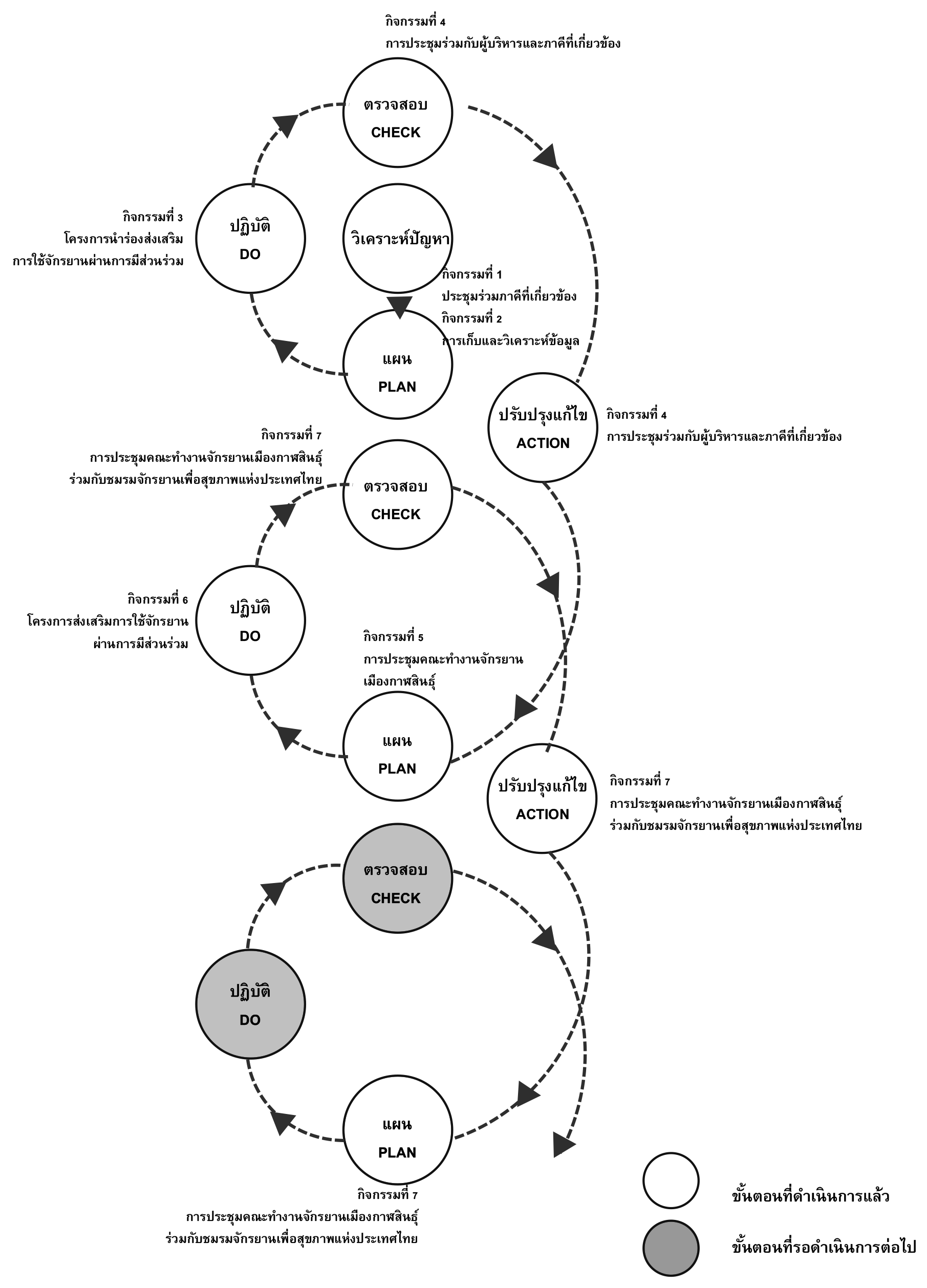Participatory Action Research in Promoting Safe Bike to School
Main Article Content
Abstract
The research aims to explore the principals of Participatory Action Research in cycling promotion, including the PAR process, and evaluate its effectiveness. Kalasin municipality was selected to be a study area. The target group was primary school pupils from five local schools. The research employed multiple methods including a documentation, a site survey, a questionnaire and a focus group. This study had been preceded from April – December 2015. It found that PAR was a kind of knowledge accumulation, combining social and pedagogic sciences, together with action learning. This PAR research consisted of 7 steps including 1) an introduction and interview with the mayor and relevant actors, 2) a questionnaire with pupils, 3) Creative Cycling Promotion Project, 4) a meeting with the municipality’s leaders, 5) a cycling committee meeting, 6) Healthy Pupils Cycling Project, and 7) a meeting with Thai Cycling Club. As a results, the actions initiated from this PAR were the Creative Vacation Project, the committee meeting, the Healthy Pupils Cycling Project, Cycling Community Project, Cycling Family Project, and Local Cycling Personal Training.
Downloads
Article Details

This work is licensed under a Creative Commons Attribution-NonCommercial-NoDerivatives 4.0 International License.
All material is licensed under the terms of the Creative Commons Attribution 4.0 International (CC-BY-NC-ND 4.0) License, unless otherwise stated. As such, authors are free to share, copy, and redistribute the material in any medium or format. The authors must give appropriate credit, provide a link to the license, and indicate if changes were made. The authors may do so in any reasonable manner, but not in any way that suggests the licensor endorses you or your use. The authors may not use the material for commercial purposes. If the authors remix, transform, or build upon the material, they may not distribute the modified material, unless permission is obtained from JARS. Final, accepted versions of the paper may be posted on third party repositories, provided appropriate acknowledgement to the original source is clearly noted.
References
Chaowarat, P., Sawangchaeng, S. & Piriyakarnnon, M. (2013). Research for cycle facility promotion in Maha Sarakham city. National Research Council of Thailand.
Chaowarat, P., Sawangchaeng, S. & Piriyakarnnon, M. (2015). Soft measures for cycling promotion in the northeast of Thailand. Faculty of Architecture, Urban Design and Creative Arts, Mahasarakham University.
Chiara, J. D. & Koppelman, L. E. (1982). Urban planning and design criteria (3rd ed.). New York: Van Nostrand Reinhold.
Davies, D., Halliday, M. E., Mayes, M. & Pocock, R. L. (1997). Attitudes to cycling: A quantitative study and conceptual framework. UK: Transport Research Laboratory [TRL].
Fawcett, S. B. (1990). Some emerging standards for community research and action: Aid from a behavior perspective. In P. Tolan, C. Keys, F. Chertok & L. Jason (Ed.). Researching community psychology: Issues of theory and methods (pp. 64-75). Washington (DC): APA.
Federal Ministry of Transport, Building and Housing. (2002). National cycling plan 2002-2012. Berlin: Federal Ministry of Transport, Building and Housing.
Fishman, E., Garrard, J. & Litman, T. (2011). Cost and health benefit of active transport in Queensland (Research and Review). Australia: CATALYST for Health Promotion Queenland.
Graves, W. (1992). Participatory research: A partnership among individuals with disabilities, rehabilitation professionals, and rehabilitation researchers. Rehabilitation Education, 6, 221-224.
Iamtrakul, P., Simcharean, P. & Jantaworn, P. (2012). Participation of local communities in road safety through Participation Research Approach (PAR): A case study of Thakhlong Municipality, Pathumthani. Journal of Architectural/Planning Research and Studies, 9(1), 61-81.
Jones, M. (2001). Promoting cycling in the UK: Problems experienced by the practitioners. World Transport Policy and Practice, 7(3), 7-12. Retrieve from http://www.ecoplan.org/wtpp.
McClintock, H. (2002). Planning for cycling, principles, practices and solutions for urban planners. England: Woodhead.
Minkler, M. (2000). Using participatory action research to build healthy communities. Public Health Reports, 115(2-3), 191-197.
Neun, M. (2015). Speech in the closing ceremony. Paper presented at the Velo City’ 15 conferences, June 2-5, Nates, France.
O’Fallon, L. R., Tyson, F. L. & Dearry, A. (2003). Successful models of community-based participatory research. Retrieved October 2, 2003, from http://www.niehs.nih.gov/translat/cbr-final.pdf.
Reason, P. & Rowan, J. (1981). Human inquiry: A sourcebook of new paradigm research. New York: Wiley.
Traffic and Transportation Unit. (1992). Feasibility study of bike lane development]. Bangkok: Faculty of Engineering, Chulalongkorn University.
White, G. W., Suchowierska, M. & Campbell, M. (2004). Developing and systematically implementing participatory action research. Archives of Physical Medicine and Rehabilitation, 85(2), s3-s12.


